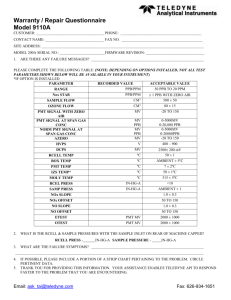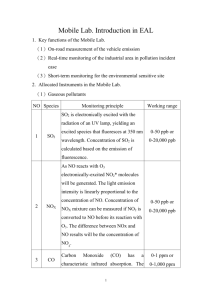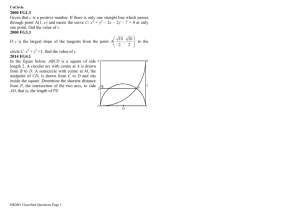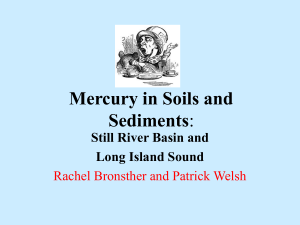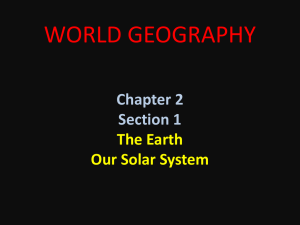Chemical composition of Earth,Venus, and Mercury
advertisement
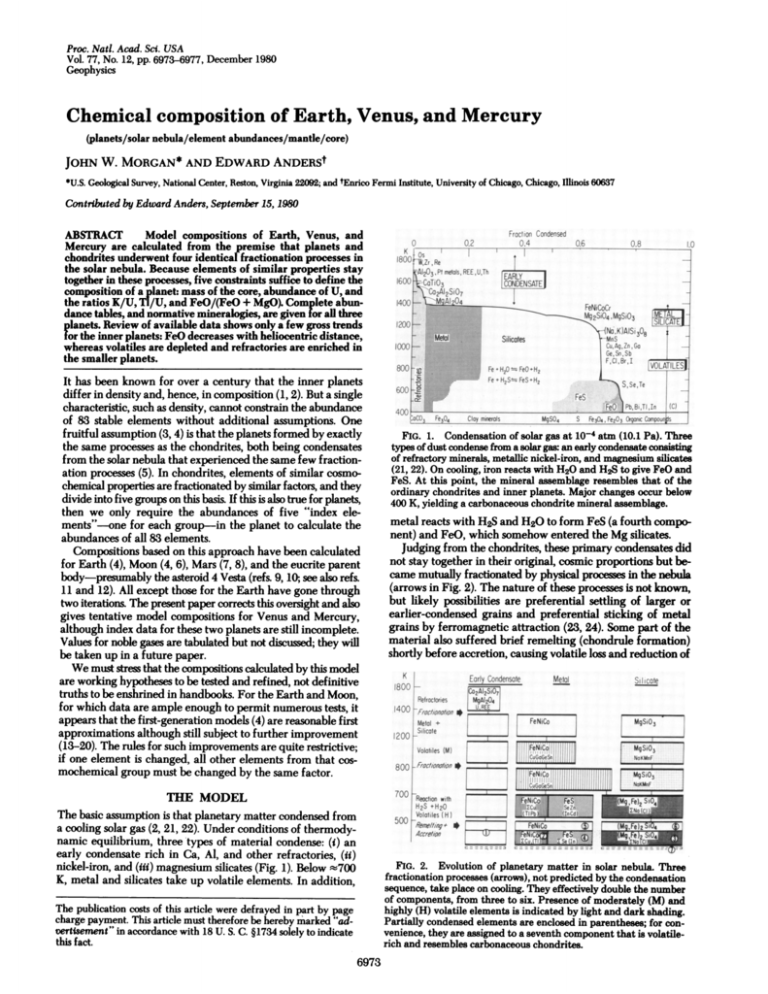
Proc. Nati. Acad. Sci. USA
Vol. 77, No. 12, pp. 6973-6977, December 1980
Geophysics
(planets/solar nebula/element abundances/mantle/core)
JOHN W. MORGAN* AND EDWARD ANDERSt
FeNECo-{~Mg,)2
14GC_\~ ~ MgA
Chemical composition of Earth, Venus, and Mercury
*U.S. Geological Survey, National Center, Reston, Virginia 22092; and tEnrico Fermi Institute, University of Chicago, Chicago, Illinois 60637
Contributed by Edward Anders, September 15,1980
ABSTRACT
Model compositions of Earth, Venus, and
Mercury are calculated from the premise that planets and
chondrites underwent four identical fractionation processes in
the solar nebula. Because elements of similar properties stay
together in these processes, five constraints suffice to define the
composition of a planet: mass of the core, abundance of U, and
the ratios K/U, Tl/U, and FeO/(FeO + MgO). Complete abundance tables, and normative mineralogies, are given for all three
planets. Review of available data shows only a few gross trends
for the inner planets: FeO decreases with heliocentric distance,
whereas volatiles are depleted and refractories are enriched in
the smaller planets.
-V,Zr, Re
-Al 0 1Pt rnefa!5, REEU,Th
1600
CoTi03
CONDENSATE
~
Me0tal
FeO+H2
MTA
SILICTE
ifa.K)AISi3O
MnS
Cu, Ag, Zn Ga
Ge, Sn, S b
F,
C1,Br,
I1i
VOLTILES
Fe~~zbrBI ril~~n
4~~~~~0
Fe304
q2iO.MS0
2°S'4 Mg S IO3m
BJ1 J
4nG
-
oC03
1.0
SSeTe
'FeHSFeS.H2
FeS
(r}F1
Ii ~ ~ ~ ~ ~ ~ ~ Pb,siI
2
600
0.8
1e~lo~
~ ~
Silicates
Fe H 0
Clay minerals
MgSQ4
1
Fe3t4, Fe2O3 Organic Compont
S
FIG. 1. Condensation of solar gas at 10-4 atm (10.1 Pa). Three
types of dust condense from a solar gas: an early condensate consisting
of refractory minerals, metallic nickel-iron, and magnesium silicates
(21, 22). On cooling, iron reacts with H20 and H2S to give FeO and
FeS. At this point, the mineral assemblage resembles that of the
ordinary chondrites and inner planets. Major changes occur below
400 K, yielding a carbonaceous chondrite mineral assemblage.
metal reacts with H2S and H20 to form FeS (a fourth component) and FeO, which somehow entered the Mg silicates.
Judging from the chondrites, these primary condensates did
not stay together in their original, cosmic proportions but became mutually fractionated by physical processes in the nebula
(arrows in Fig. 2). The nature of these processes is not known,
but likely possibilities are preferential settling of larger or
earlier-condensed grains and preferential sticking of metal
grains by ferromagnetic attraction (23, 24). Some part of the
material also suffered brief remelting (chondrule formation)
shortly before accretion, causing volatile loss and reduction of
EaorlyCiondensote
K
Refroctories
MgAI2O4
400 -,rnrtinn nonn *
,-
U200
_
FeNiCo
Metal +
SIncote
FraoctionOtiron *
800
Ls
tReactiso
5
with
;Accretion
jmgS103
|
FeNiCo
~e~
:
H2s nH20
Volatiles (H
riRerel/Ing +
Sil iCate
.FeNiCo
CuGaGeSn
Volatiles (Ml
500
Metal
1sIo,1
1800 -
700
THE MODEL
The basic assumption is that planetary matter condensed from
a cooling solar gas (2, 21, 22). Under conditions of thermodynamic equilibrium, three types of material condense: (i) an
early condensate rich in Ca, Al, and other refractories, (ii)
nickel-iron, and (iii) magnesium silicates (Fig. 1). Below --700
K, metal and silicates take up volatile elements. In addition,
-AL
A
Co2Al~~~~~~srO7
_
MgAI204
140C.
800
It has been known for over a century that the inner planets
differ in density and, hence, in composition (1, 2). But a single
characteristic, such as density, cannot constrain the abundance
of 83 stable elements without additional assumptions. One
fruitful assumption (3, 4) is that the planets formed by exactly
the same processes as the chondrites, both being condensates
from the solar nebula that experienced the same few fractionation processes (5). In chondrites, elements of similar cosmochemical properties are fractionated by similar factors, and they
divide into five groups on this basis. If this is also true for planets,
then we only require the abundances of five "index elements"-one for each group-in the planet to calculate the
abundances of all 83 elements.
Compositions based on this approach have been calculated
for Earth (4), Moon (4, 6), Mars (7, 8), and the eucrite parent
body-presumably the asteroid 4 Vesta (refs. 9, 10, see also refs.
11 and 12). All except those for the Earth have gone through
two iterations. The present paper corrects this oversight and also
gives tentative model compositions for Venus and Mercury,
although index data for these two planets are still incomplete.
Values for noble gases are tabulated but not discussed; they will
be taken up in a future paper.
We must stress that the compositions calculated by this model
are working hypotheses to be tested and refined, not definitive
truths to be enshrined in handbooks. For the Earth and Moon,
for which data are ample enough to permit numerous tests, it
appears that the first-generation models (4) are reasonable first
approximations although still subject to further improvement
(13-20). The rules for such improvements are quite restrictive;
if one element is changed, all other elements from that cosmochemical group must be changed by the same factor.
Frct'ion Condensed
0.4
0.6
0.2
K
*
MgSrO3
NaKMnF
eM
FeNiCo
I-!FeNiC'
m
A
m
ASe,i d
...E~T
geS
1NoKMnF
Si04_
(Mg.Fe 2 SiO4
MMQapgFe ) FIfSiO_
FIG. 2. Evolution of planetary matter in solar nebula. Three
fractionation processes (arrows), not predicted by the condensation
sequence, take place on cooling. They effectively double the number
of components, from three to six. Presence of moderately (M) and
highly (H) volatile elements is indicated by light and dark shading.
Partially condensed elements are enclosed in parentheses; for convenience, they are assigned to a seventh component that is volatilerich and resembles carbonaceous chondrites.
The publication costs of this article were defrayed in part by page
charge payment. This article must therefore be hereby marked "adtveisement" in accordance with 18 U. S. C. §1734 solely to indicate
this fact.
6973
-:. Ir_. . . . .
Proc. Natl. Acad. sci. USA 77 (1980)
Geophysics: Morgan and Anders
6974
L IBe
LL
F
1
A I SK t Ar
No Mg
K Co Sc Ti V Cr Mn FelCo Ni Cu Zn Go GeJA Sej`B- r
Rb Sr Y Zr Nb Mo Tc Ru Rh Pd A
Sn Sb Te X
Cs,.Bo La Hf Ta W Re Os Ir Pt E Tl94 PpjB/i- o,
,1
3.)m:c....
Vclak.er
H
VENUS 0
m
C3Vo
_
J
1
CHONDRITES
5 RuU C /04 /05 /06 /07 /08 /09 1/0 ///11//4/j
j/f<j. //6
iL12° 121 Ce Pr Nd Pm Srn Eu Gd Tb Dy Ho Er Tm Yb Lu
Th Po U N/o Pu Am Cmn 8k Cf Es fmn MWdA/o Lw
/
1
SHERGOTTITES *
EARTH
:
.
MARS
EUCRITES
U
Hlighlands
-
Ave Surface
FIG. 3. Elements condensing from a solar gas divide into five
major groups on the basis of volatility. These groups stay together,
more or less, in gas/dust fractionations.
FeS to metal. Two additional components are thus made:
remelted metal and remelted silicate (numbers 5 and 6 in Fig.
2).
The 19 highly volatile elements condensing below 600 K
present a special problem because they may be only partly
condensed, to an extent that cannot be predicted a priori but
may be determined empirically from observed abundances.
For convenience, these elements may be assigned to a seventh,
volatile-rich component (no. 7 in Fig. 2) resembling some type
of carbonaceous chondrite (4). [Actually, this "group" consists
of three subgroups-volatile metals, major volatiles such as H,
C, and N, and noble gases-that differ in condensation behavior
and should really be represented by three different index elements (7, 8).]
Sulfur also is hard to constrain. Its cosmic abundance is
comparable to that of Fe [5.0 X 105 vs. 8.9 X 105 atoms/106 Si
atoms (4, 25)] and so it may not fully condense if less than 5 X
105 atoms of Fe' remain after metal loss and FeO formation.
Hence, we normally base S on the cosmic S/K ratio or on the
amount of available Fe, whichever is smaller (4, 6). However,
these values may be too low; part of the S volatilized during
chondrule formation may recondense because the back-reaction
between Fe and H2S is rather fast (21). At least for Earth, there
is an additional clue: the density of the core implies the presence
of %10% of some light element such as S or 0 or both (26, 27).
We have chosen a value of 9% S for Earth's core.
Although the model has seven components, it actually has
only six degrees of freedom. The fraction remelted is the same
for metal, sulfide, and silicate; and only six components are
needed to define the seventh (e.g., silicate) because the sum of
the seven equals the mass of the planet.
Each component carries its own suite of elements (Fig. 3) in
generally cosmic proportions, so if we know U, for example, we
know the abundance of 37 other refractory elements in the
planet. Thus, we only need global abundances of five "index
elements" to determine the planet's composition (Table 1).
Table 1. Index elements and ratios
Component Tond K Index Earth Venus* Mercury*
Early
condensate
Metal
>1400
14001300
U, ppb
14.3
15
32
32.4
Core, %
9440
10,000
Unremelted 1300-60 K/Ut
0.27
0.27
<600
Tl/Ut
Volatile-rich
0.07
0.12
FeO
#900 -50
f1
*
Poorly determined values are given in italics.
t Mass ratios.
t f = molar ratio, FeO/(FeO + MgO).
~~~~Ave
11
68
2000
0.004
0.03
MOON
2
IC3
K ppro
FIG. 4. K/U ratios of meteorites and planets. Several chondrite
classes (30) have K/U ratios below the C1 chondrite value (star), reflecting depletion of K during chondrule formation (remelting). Ratios
in planetary surface rocks (4, 31-33, t) and differentiated meteorites
(30) are even lower. Because K and U do not fractionate readily in
igneous processes, these ratios may be representative of the bulk
planets. 0, K/U; 0, K/Th X 3.6.
The first two, in principle, can be estimated directly from
geophysical data (heat flow, density), with some iteration via
thermal and seismic models. Fe can thus be determined to
better than +10% in all three planets, but U is known to only
about +30% in the Earth (28, 29) and not at all for Venus and
Mercury; the (Earth-like and Moon-like) values in Table 1 are
educated guesses, based on the apparent trend of U content with
size (8) and a few scraps of evidence suggesting Earth-like and
Moon-like composition for these two planets.
The next two index elements, K and TI, can be estimated
from their abundance ratios relative to U in surface rocks. These
ratios tend to be nearly constant in a given planet (Fig. 4), reflecting the coherence of these large ions in igneous processes
(3, 31). Three U values for Venus are known from 'y-ray spectrometry by the spacecraft Venera 8, 9, and 10 (32, i); three
additional values (open circles in Fig. 4) can be derived indirectly from the Th values by using the rather constant Th/U
ratio in meteorites and many igneous rocks, 3.6. The single value
for Mars is rather uncertain.t No data whatsoever are available
for Mercury, and we have therefore used the average Py-ray
spectrometric value for the surface of the Moon (33).
In the same spirit, we have chosen Earth-like and Moon-like
Tl/U ratios for Venus and Mercury (Table 1), based mainly on
the similar C and N contents of Earth and Venus (7, 34) and the
distinctly lower volatile abundances of smaller planets such as
Mars and the Moon (8). These values may be adequate for
volatile trace metals and H, C, and N but not for noble gases.
The last index, FeO, measures the degree to which Fe became oxidized in the solar nebula (Figs. 1 and 2). In principle,
it is given by the average FeO/(FeO + MgO) in the mantle
silicates, but even for the Earth, this value is not directly determined because the lower mantle, of possibly higher FeO
content (20), has not yet been sampled. Nonetheless, geophysical
models point to a ratio of 0.12 + 0.02 (35). Beyond the Earth,
this ratio seems to increase with distance from the Sun, judging
both from the abundance of Fe2+ 3+ in surface rocks (which is
related to FeO content of the mantle) and from model compositions for Mars and the eucrite parent body (Fig. 5). The
three classes of ordinary chondrites fit smoothly into this trend,
*
Surkov, Yu. A. (1980) Paper presented
Budapest, Hungary, 2-14 June 1980.
at
23rd COSPAR Meeting,
Geophysics: Morgan and Anders
Element
H, ppm
4He*
Li, ppm
Be, ppb
B, ppb
C, ppm
N, ppm
0, %
F, ppm
20Ne*
Na, ppm
Mg, %
Al, %
Si, %
P, ppm
S, %
Cl, ppm
S6Ar*
K, ppm
Ca, %
Sc, ppm
Ti, ppm
V, ppm
Cr, ppm
Mn, ppm
Fe, %
Co, ppm
Ni, %
Cu, ppm
Zn, ppm
Ga, ppm
Ge, ppm
As, ppm
Se, ppm
Br, ppb
84Kr*
Rb, ppb
Sr, ppm
Y, ppm
Zr, ppm
Nb, ppb
Mo, ppm
Earth
33
111
1.85
45
9.6
446
4.1
30.12
13.5
0.50
1250
Proc. Natl. Acad. Sci. USA 77 (1980)
Table 2. Elemental abundances in Earth, Venus, and Mercury
Venus
Mercury
Element
Earth
1.18
0.4
Ru, ppm
35
252
Rh, ppb
11,000
0.89
0.87
1.94
Pd, ppm
44
34
Ag, ppb
47
16.4
0.11
10.0
Cd, ppb
2.14
5.1
468
In, ppb
390
0.046
4.3
Sn, ppb
35
14.44
Sb, ppb
30.90
1490
2.2
15
Te, ppb
13.6
49
I, ppb
0.0168
132Xe*
200
1390
15.3
6.50
14.54
Cs, ppb
4.0
1.08
1.48
Ba, ppm
379
La, ppb
15.82
7.05
1010
390
Ce, ppb
1860
129
Pr, ppb
0.24
1.62
690
0.23
20.9
Nd, ppb
208
210
Sm, ppb
79
22
150
Eu, ppb
286
1.18
1.61
Gd, ppb
54
7.4
Tb, ppb
10.1
364
Dy, ppb
850
630
80
Ho, ppb
63
86
231
Er, ppb
7180
4060
35
150
Tm, ppb
460
229
Yb, ppb
64.47
31.17
386
Lu, ppb
1690
820
230
3.66
1.77
Hf, ppb
23.3
5.1
Ta, ppb
35
180
12.1
82
W, ppb
60
3.4
Re, ppb
0.50
880
1.24
8.4
Os, ppb
840
Ir, ppb
3.1
6.4
1.67
5.4
0.79
Pt, ppm
257
111
Au, ppb
1.2
7.9
2.30
Hg, ppb
3.86
75
509
T1, ppb
1.58
1.11
15.2
204Pb, ppb
2.94
2.01
2.74
Bi, ppb
5.5
51.2
7.5
Th, ppb
840
14.3
610
U, ppb
2.47
1.81
6975
Venus
Mercury
1.23
265
0.87
49
17.2
2.24
430
39
830
14.3
0.91
194
1.79
7.2
0.19
0.024
64
5.7
122
0.16
1.61
2.5
17.0
13.90
3.1
4.2
1.41
291
397
15.12
780
1060
1920
99
135
2.92
530
723
19.9
160
218
2.20
61
83
135
220
300
1.54
41
56
9.6
280
382
820
61
84
82
177
242
4120
27
37
750
176
240
32.07
297
405
840
177
241
1.82
17.9
24.4
31
139
189
74
46
64
3.1
670
920
7.6
650
890
3.2
1.29
1.76
9.6
516
250
106
0.09
8.3
0.0236
0.044
4.05
458
1.66
0.018
14.5
0.034
2.62
3.08
7.2
39.4
53.7
800
11.0
15.0
2.35
Most values are based on the solar-system abundances of Cameron (25), with some later revisions (4). H, C, and N are based on their ratios
to Tl in C3V chondrites (7). B and F (9 and 780 atoms per 106 Si) data are from A.G.W. Cameron (personal communication), and Zr was changed
to 12.9 atoms/106 Si. Cs, an element lying between the two main groups of volatiles, was adjusted to the empirical Rb/Cs ratio in the Earth's
crust, 30. Values in italics are poorly determined.
* Noble gas concentrations are given in units of 10-8 cm3/g. The values for Venus are scaled to the Pioneer Venus 36Ar value and may well be
too high by substantial factors.
if placed at arbitrary distances of 1.2-2 AU, the place of origin
favored by some authors (36).
On the sunward side of the Earth, two data points are available. A spectrophotometric measurement for Mercury (37)
suggests that pyroxenes on its surface have about the same FeO
content as do those in lunar highland soils-i.e., 5.5%. This FeO
must come from local rock, not from a meteoritic component,
because the latter typically comprises less than 4% of a regolith
and contains <30% FeO (38). For Venus, the latest thermodynamic calculations, assuming equilibrium between surface
rocks and the atmosphere (39), suggest an FeO activity of
10-3-10-2-i.e., 1-2 orders of magnitude below the value for
the Earth. But this result applies only to the surface rocks, whose
chemistry is controlled by the massive, hot atmosphere. It does
not preclude a higher FeO content in the bulk planet.
On the strength of the Mercury point-unaffected by an
atmosphere-it appears that the FeO content of planetary
matter falls much less steeply with heliocentric distance than
expected from the Fe/FeO equilibrium in Fig. 1 and an a-0.5
dependence of T (dashed line in Fig. 5), let alone the still steeper
T-dependence (ta-"1) favored by some authors (36). We have
therefore chosen rather high FeO contents for Venus and
Mercury (Table 1), based on the (tenuous!) assumption that the
trend in Fig. 5 is monotonic.
It is an interesting question why the FeO content of planets
varies so little with heliocentric distance (Fig. 5). One possibility
is a very small temperature gradient in the solar nebula, smaller
than any considered in theoretical models. Such a flat gradient
has been suggested by meteorite data all along (40) but, because
such planetesimals should also be rich in C, H, noble gases, and
other volatiles, one would expect a strong correlation of these
volatiles with FeO, which is not observed. Perhaps the FeO
content was established in protoplanets (41) rather than in the
solar nebula, but then one would expect little correlation with
heliocentric distance. A final, speculative possibility is that FeO
was inherited mainly from a presolar stage.
Geophysics: Morgan and Anders
6976
Proc. Natl. Acad. Sci. USA 77 (1980)
40
T
30
T4
-
1
*L
-
20
'T
/
0
N'
I0
0
8
6
/
1)
/
/
_
-
Il
0a1
4
f
0.5
Distance
2
fromn
Sun
AU
FIG. 5. Both the surface and bulk FeO contents of planets (35)
decrease with heliocentric distance a but less steeply than expected
from the Fe/FeO equilibrium (22) and an a-05 dependence of T
(dashed line). The letters H, L, and LL designate the corresponding
classes of ordinary chondrites. 0, Fe2+,3+, surface; *, FeO/(FeO +
MgO), bulk.
MODEL COMPOSITIONS OF THE EARTH,
VENUS, AND MERCURY
The compositions, calculated as in Morgan et al. (6), are given
in Tables 2 and 3. For Earth, various lines of evidence supporting the previous model should equally apply to the present
one: an empirical estimate of bulk composition (18), the Rb/Sr
ratio inferred from the isotopic composition of Sr in surface
rocks (20, 42), mantle abundances of F, C1, Br, Rb, and Ba (19)
and Ni and Ge (43). For Venus and Mercury, no tests are possible yet in the absence of geochemical data.
Mineral compositions for >30 kb correspond to garnet
lherzolite (Table 4). Less than half of the thin Mercurian mantle
Table 3.
Model compositions of Earth, Venus, and Mercury
Mantle + crust, %
Sio2, %
TiO2, %
A1203,
%
Cr203, %
MgO, %
FeO, %
MnO, %
CaO, %
Na2O, %
H20, %
K, ppm
U, ppm
Th, ppm
Core, %
Fe, %
Ni, %
S, %
Co, %
P, %
Earth
Venus
Mercury
67.6
47.9
0.20
3.9
0.9
34.1
8.9
0.14
3.2
0.25
0.21
200
0.021
0.076
68.0
49.8
0.21
4.1
0.87
35.5
5.4
0.09
3.3
0.28
0.22
221
0.022
0.079
32.0
47.1
0.33
6.4
3.3
33.7
3.7
0.06
5.2
32.4
88.8
5.8
4.5
0.27
0.62
32.0
88.6
5.5
5.1
0.26
0.58
68.0
93.5
5.4
0.35
0.25
0.57
0.08
0.016
69
0.034
0.122
Table 4. Normative mineralogical composition of Earth, Venus,
and Mercury
Earth
Venus
Mercury
30 kb
30 kb
30 kb
0 kb
Mantle, wt %
67.6
68.0
32.0
32.0
Chromite
0.94
0.88
3.34
3.34
Ilmenite
0.24
0.27
0.42
0.42
Jadeite
1.78
1.95
0.61
Plagioclase
16.52
Alkali feldspar
0.76
Anorthite
15.76
Ca-rich pyroxene
11.76
12.14
18.97
6.37
Hedenbergite
1.45
0.86
0.60
0.20
Diopside
10.31
11.27
18.37
6.17
Ca-poor pyroxene
33.22
39.90
24.02
36.01
Ferrosilite
4.10
2.84
0.76
1.14
Enstatite
29.12
37.06
23.26
34.87
Olivine
37.82
30.30
27.43
37.35
Fayalite
4.67
2.16
0.87
1.19
Forsterite
33.15
28.14
26.56
36.16
Garnet
14.22
14.56
25.21
Almandine
1.75
1.04
0.80
Pyrope
12.47
13.53
24.41
Core, wt %
32.4
32.0
68.0
Metal
75.33
86.10
99.05
Fe
68.86
79.74
92.85
Ni
5.61
5.52
5.38
Co
0.26
0.26
0.25
P
0.59
0.58
0.57
Troilite
24.68
13.90
0.96
Fe
15.68
8.83
0.61
S
9.00*
5.07
0.35
Mantle values in mol % and core values in weight %; each normalized to 100%6.
* Density data for the core may also be satisfied by some mixture of
S and 0 rather than by S alone. One possible combination is S =
4.51% (corresponding to a cosmic S/K ratio) and 0 = 4.49%, leaving
Femew = 61.01%, Fetroilite = 7.58%, and Feoxide = 15.68%.
attains this pressure, and at 0 kb the assemblage is plagioclase
lherzolite. For the Earth, the 30-kb composition resembles the
more fertile natural garnet lherzolites but has less olivine. Most
garnet lherzolites are probably partly residual and may be
richer in olivine than is primitive mantle material (44). The
30-kb assemblage for Venus resembles that of the Earth except
for orthopyroxene < olivine. This would be unusual for an
equivalent terrestrial rock and reflects a high Si/(Fe + Mg),
resulting from low FeO in the Cytherean mantle. On Mercury,
the high refractory content leads to abundant garnet (30 kb)
and plagioclase (0 kb); in corresponding terrestrial rocks these
generally occur only as accessory minerals.
Planetary mantle mineral compositions derived from averaged compositional estimates (35) in the system CaO-MgOA1203-SiO2 suggest two assemblage sequences (45). Earth,
Venus, and the Moon yield plagioclase lherzolite (0-10 kb),
spinel lherzolite (10-25 kb), and garnet lherzolite (>25 kb),
whereas Mars and Mercury give spinel plagioclase wehrlite,
spinel lherzolite, and spinel-garnet wehrlite at corresponding
pressures. Using our compositional data, however, we find that
all five planets follow the lherzolite sequence, except for Mars,
which enters the garnet-wehrlite field at >25 kb.
Now that model compositions are available for six planets,
let us look for trends (Fig. 6). Compositions are represented by
the five indices from Table 1, poorly known values being indicated by open symbols. The observed range for chondrites
is also shown, to check our premise that chondrites and planets
were made by the same processes. Two first-order trends are
Proc. Natl. Acad. Sci. USA 77 (1980)
Geophysics: Morgan and Anders
Open Symbols = Poorly Known
U Eucrite Parent Body - Chondrite Range
U -group
>1400 K
WjIE -U-H
Fe -group
1300 -1400 K
I
.
0.3
ST
Fe
1St
6
3
0.6
U/Si
3
2
0.5
0.3
K - group
600 -1300 K
0.03
0.06
0.3
0.1
0.6
TI -group
<600K
10-4
Oxidation
of Fe
0
101
00.,o72
in
0
0.1
0
0.2
03
0.3
0.4
0.
0.5
FIG. 6. Chemical composition of planets. Planet composition
shows little correlation with heliocentric distance and only a gross
correlation with mass: relative to Earth and Venus, the four small
planets are depleted in volatiles but (except for the eucrite parent
body) enriched in refractories. The small planets also show more extreme fractionation, often falling outside the chondritic range. E,
Earth; V, Venus; Ma, Mars; Me, Mercury; Mo, Moon.
the decline of FeO/FeO+MgO with heliocentric distance and,
for the four other indices, the dichotomy between the two large
planets-Earth and Venus-and the three small ones-Mars,
Mercury, and the Moon. The latter show more extreme fractionations: enrichments (U group), depletions (K group, Tl
group), or both (Fe group). Beyond that, there are no clear
trends, although the generally low position of the smallest and
most remote body-the eucrite parent body-suggests that
some further regularities may be hidden in the data. However,
it seems unlikely that the data will ever fall into a neat, monotonic sequence according to mass or heliocentric distance. As
pointed out before (7, 8), some chondrite classes and shergottites-an achondrite class resembling eucrites-match or surpass the Earth in volatile content (46, 47), although they are
derived from smaller and more remote bodies. Apparently,
mass and heliocentric distance were not the only factors controlling planet composition.
The dichotomy between large and small planets also shows
up in the comparison with chondrites. Values for Earth and
Venus always fall within the chondritic range, whereas values
for the small planets often fall outside. This does not necessarily
imply a whole new set of processes because the "chondritic
range" is based on a manifestly incomplete sampling of the
asteroid belt. And the very factors that caused planets to grow
beyond asteroidal size may also have driven the fractionation
processes to greater extremes [e.g., enrichment of U group by
preferential accretion of early condensate (24)].
The strongest case for a wholly different process can be made
for the K group where the planets lie at or below the low end
of the chondritic range and for the Fe group where the most
extreme values are shown by the Moon (the only satellite) and
by Mercury (the planet closest to the Sun). Some authors have
explained these bodies by special processes: the Moon, by fission
(48) or by collisional differentiation of planetesimals, enriching
brittle silicates over ductile nickel-iron (49); and Mercury, by
arrested condensation at i1400 K (Fig. 1) or by gas drag (50).
We prefer to invoke the same mechanism (ferromagnetism?)
that was responsible for Fe/Si fractionations among chondrites
and the remaining planets. The choice obviously depends on
one's faith in Occam's razor.
This work was supported in part by National Aeronautics and Space
Administration Contract T-4089F and Grant NGL-14-001-010.
6977
1. Greg, R. P., Jr. (1855) Am. J. Sci. (series 2) 19, 143-144.
2. Urey, H. C. (1952) The Planets (Yale Univ. Press, New Haven,
CT).
3. Krihenbfihl, U., Ganapathy, R., Morgan, J. W. & Anders, E.
(1973) Fourth Proc. Lunar Sci. Conf. 1325-1348.
4. Ganapathy, R. & Anders, E. (1974) Fifth Proc. Lunar Sci. Conf.
1181-1206.
5. Anders, E. (1971) Annu. Rev. Astron. Astrophys. 9, 1-34.
6. Morgan, J. W., Hertogen, J. & Anders, E. (1978) The Moon and
the Planets 18, 465-478.
7. Anders, E. & Owen, T. (1977) Science 198,453-465.
8. Morgan, J. W. & Anders, E. (1979) Geochim. Cosmochim. Acta
43, 1601-1610.
9. Hertogen, J., Vizgirda, J. & Anders, E. (1977) Bull. Am. Astron.
Soc. 9, 458-459 (abstr.).
10. Morgan, J. W., Higuchi, H., Takahashi, H. & Hertogen, J. (1978)
Geochim. Cosmochim. Acta 42, 27-38.
11. Consolmagno, G. J. & Drake, M. J. (1977) Geochim. Comochim.
Acta 41, 1271-1282.
12. Dreibus, G. & Wanke, H. (1980) Z. Naturforsch. 35a, 204-216.
13. Hodges, F. N. & Kushiro, I. (1974) Fifth Proc. Lunar Sc. Conf.
505-520.
14. Taylor, S. R. & Jakes, P. (1974) Fifth Proc. Lunar Sci. Conf.
1287-1305.
15. Walker, D., Longhi, J. & Hays, J. F. (1975) Sixth Proc. Lunar Sci.
Conf. 1103-1120.
16. Weill, D. F. & McKay, G. A. (1975) Sixth Proc. Lunar Sci. Conf.
1143-1158.
17. Longhi, J. (1977) Eighth Proc. Lunar Sci. Conf. 601-621.
18. Smith, J. V. (1977) Eighth Proc. Lunar Sci. Conf. 333-369.
19. Schilling, J.-G., Bergeron, M. B. & Evans, R. (1980) Phil. Trans.
R. Soc. London Ser. A 297, 147-178.
20. Anderson, D. L. (1980) Science, in press.
21. Larimer, J. W. & Anders, E. (1967) Geochim. Cosmochim. Acta
31, 1239-1270.
22. Grossman, L. & Larimer, J. W. (1974) Rev. Geophys. Space Phys.
12, 71-101.
23. Wood, J. A. (1962) Nature (London) 194, 127-130.
24. Anders, E. (1977) Phil. Trans. R. Soc. London Ser. A 285,2340.
25. Cameron, A. G. W. (1973) Space Sci. Rev. 15,121-146.
26. Brett, R. (1976) Rev. Geophys. Space Phys. 14, 375-383.
27. Ahrens, T. R. (1980) Science 207, 1035-1041.
28. Taylor, S. R. (1979) Lunar Planet. Sci. 10, 1217-1218.
29. Davies, G. F. (1980) J. Geophys. Res. 85,2517-2530.
30. Mason, B. (1979) in Data of Geochemistry, ed. Fleischer, M., 6th
Ed., B1-B132.
31. Wasserburg, G. J., MacDonald, J. F., Hoyle, F. & Fowler, W. A.
(1964) Science 143, 465-467.
32. Surkov, Yu. A. (1977) Gamma Spectrometry in Cosmic Investigations (Atomizdat, Moscow).
33. Metzger, A. E., Haines, E. L., Parker, R. E. & Radocinski, R. G.
(1977) Eighth Proc. Lunar Sci. Conf. 949-999.
34. Pollack, J. B. & Black, D. C. (1979) Science 205,56-59.
35. Wood, J. A., Anderson, D. L., Buck, W. R., Kaula, W. M., Anders,
E., Consolmagno, G., Morgan, J. W., Ringwood, A. E., Stolper,
E. & Wanke, H. (1981) in Basaltic Volcanism in the Terrestrial
Planets ed. Kaula, W. M. (Lunar & Planetary Inst., Houston, TX),
in press.
36. Lewis, J. S. (1974) Science 186, 440-443.
37. McCord, T. B. & Clark, R. N. (1979) J. Geophys. Res. 84,
7664-7668.
38. Anders, E., Ganapathy, R., Krahenbuhl, U. & Morgan, J. W.
(1973) The Moon 8, 3-24.
39. Lewis, J. S. & Kreimendahl, F. A. (1980) Icarus 42,330-37.
40. Anders, E. (1972) in L'Origine du Systeme Solaire, ed. Reeves,
H. (Paris), 179-201.
41. Cameron, A. G. W. (1978) in Protostars and Planets, ed. Gehrels,
T. (Univ. of Arizona Press, Tucson, AZ), 453-487.
42. Gast P. W. (1968) Ceochim. Cosmochim. Acta 32,1057-1086.
43. Morgan, J. W., Wandless, G. A., Petrie, R. W. & Irving, A. J.
(1980)11th Proc. Lunar Planet. Sci. Conf., in press.
44. Smith, J. V. (1979) Min. Mag. 43,1-89.
45. Stolper, E. (1980) Lunar Planet. Sci. 11, 1100-1102.
46. Laul, J. C., Keays, R. R., Ganapathy, R., Anders, E. & Morgan,
J. W. (1972) Ceochim. Cosmochim. Acta 36, 329345.
47. Stolper, E. (1979) Earth Planet. Sci. Lett. 42,239-242.
48. O'Keefe, J. A. & Sullivan, E. C. (1978) Icarus 35,272-283.
49. Kaula, W. M. (1977) Eighth Proc. Lunar Sci. Conf. 321-31.
50. Weidenschilling, S. J. (1978) Icarus 35, 99-111.
